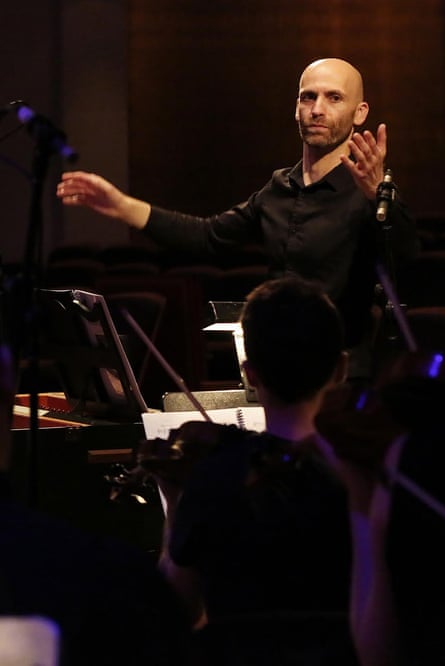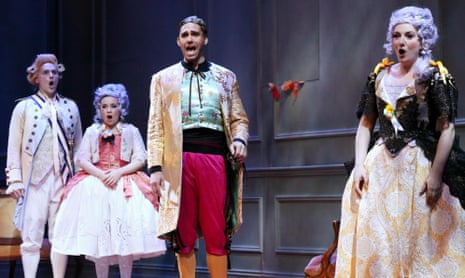While Australia’s national opera company feeds its audiences with bottom-line friendly re-runs of Romantic favourites, two minuscule opera companies in Sydney are spanning the extremities of the repertoire to offer more interesting fare.
Sydney Chamber Opera, founded in 2010 by Jack Symonds and Louis Garrick and now based at Carriageworks, produced two challenging works this year: the premiere in May of composer Eliott Gyger’s Fly Away Peter, an adaption of David Malouf’s dreamily powerful wartime novella; Italian composer Fausto Romitelli’s 2003 work, An Index of Metals, provocatively staged in November.
At the other end of the music-history continuum is Pinchgut Opera. Housed in spartan rooms within Opera Australia’s Surry Hills headquarters, Pinchgut also stages two productions a year – from the baroque era of the 17th and early 18th centuries, mixing it up between Italian and French, dramatic and comic.
July brought Vivaldi’s Bazajet, serious Italian fare about the defeat of the Ottoman emperor by Tamerlane. On Thursday it gives the Australian premiere, two-and-a-half centuries later, of André Grétry’s L’amant jaloux. The comedy holds a special place for Erin Helyard, Pinchgut’s co-founder, conductor and resident francophile, who grew up on the central coast but studied for his doctorate in Montreal.
Helyard had long been intrigued by the portrait of Grétry by the French painter Louise Vigée Le Brun. Unlike most pictures of the era, in which composers look to the heavens for inspiration, Grétry is looking straight at the viewer. “Grétry is that as a composer,” Helyard says. “He relates directly to the audience.”

Grétry, so obscure today, was known as the Moliere of music in his time. “This opera is one of his best, a forgotten masterpiece,” Helyard says. “It held the stage for something like 40 years – it was The Mousetrap of its day.” Which is saying something in an era when opera wasn’t a “heritage” art form and theatregoers expected composers to turn out new works the way pop fans do today.
Mozart was in Paris in 1778 when the opera was first performed. It’s not known whether he ever met Grétry, but the music scholar David Charlton suspects he heard the opera. “There’s one piece in the opera that sounds exactly like the Don Giovanni minuet,” Helyard says, pausing to hum it. “Some of our audience might say, ‘That sounds a bit like Mozart,’ but I would turn that on its head and say that Mozart sounds a bit like Grétry.”
Grétry was not only musically gifted and commercially astute but politically savvy as well. Having catered for the aristocracy, he survived the Revolution and was eventually made a chevalier of the legion d’honneur by Napoleon.
A culture war divided Europe in the 1750s, as Grétry was starting to work. Called the Querelle des Bouffons (the quarrel of the comic actors), it heatedly debated the comparative merits of French and Italian opera, triggered by a performance of the Italian composer Pergolesi’s music at the stuffy Academie Royale de Musique in Paris in 1752.
French opera at that time, brought to a pinnacle by the likes of Lully and Rameau, was formal, precise and text-based. Pergolesi introduced an Italian penchant for lyricism, naturalism and emotional expression.
“Grétry was the first composer to really unite those things, and he did it through the medium of opera comique, which was very new at the time in France,” Helyard says. “And that’s because he took it from the Italians. There was never any room for comedy in the French tradition – it was always tragique or lyrique.”
The plot of L’amant jaloux is silly but fun – turning on stern fathers, secret lovers and jealous fits – and has lots of catchy songs and spoken language. In this production, the music will be sung in French and the spoken parts will be in English to keep the narrative momentum going and save the audience from constantly swivelling to read surtitles. Helyard insists the mash-up of languages works well.
Comedy, he says, is actually harder to bring off than tragedy. His cast is young, good-looking and was in precociously fine voice the afternoon Guardian Australia sat in on rehearsals. Starring is Ed Lyon, the 36-year-old English tenor, making waves in the baroque repertoire overseas. The American director, Chas Rader-Shieber, also specialises in the baroque and hasworked with Helyard four times: in Hobart, Montreal and twice for Pinchgut.
Despite recent ructions in federal government funding via the Australia Council, Pinchgut is optimistic about its future. The company received no government funding in 2015 and hasn’t heard yet about 2016. Box office accounts for 59% of its revenue and philanthropy for 39%. Among its supporters are the Danny Kaye and Sylvia Fine Kaye Foundation (yes, that Danny Kaye) and the Graeme Wood Foundation. (Wood also funds Guardian Australia.) The company has enjoyed a 56% increase in private donations in 2015 over 2014.
Sydney Chamber Opera’s co-founder, Jack Symonds, is optimistic too. The company can’t rely on box office – with Carriageworks’ policy to keep prices low, it hovers down around the 10% mark. SCO does receive government funding, though suffered from former arts minister George Brandis’s cuts to small-to-medium companies. Symonds says the company anticipated the funding fall and made adjustments in advance. It also relies on philanthropy, as well as Carriageworks’ marketing and support.
SCO will also stage two operas in the Sydney festival: Passion and O Mensch! There are many practical and financial reasons why the behemoth, Opera Australia, is programming so cautiously these days. But despite these precarious times, interesting opera on a small scale is thriving.

Comments (…)
Sign in or create your Guardian account to join the discussion